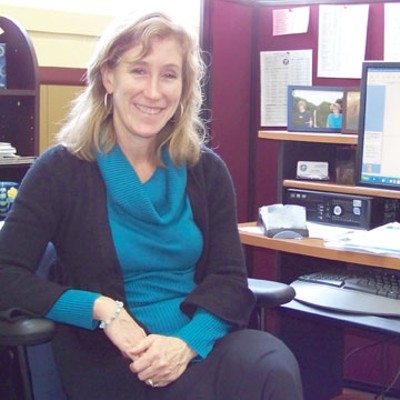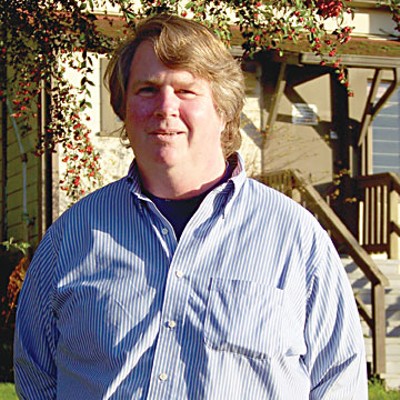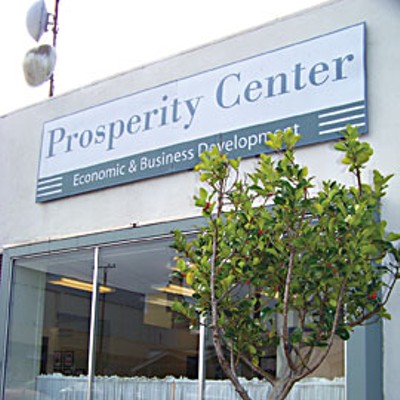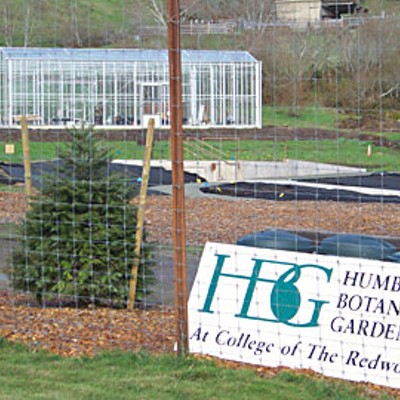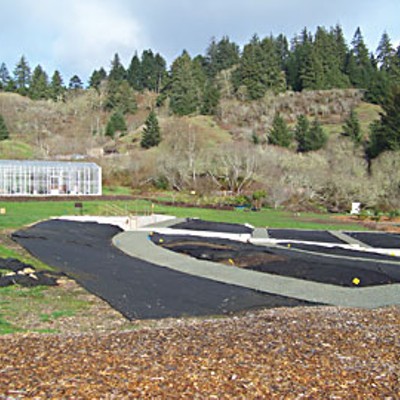Spending Headwaters
We need the economic development fund now more than ever. Who's getting the money?
By Ryan Burns [email protected] @RyanBurnsy[
{
"name": "Top Stories Video Pair",
"insertPoint": "7",
"component": "17087298",
"parentWrapperClass": "fdn-ads-inline-content-block",
"requiredCountToDisplay": "1"
}
]
Think of it as a duffel bag full of money -- more than $20 million at our disposal to spend as we see fit. It's actually a modest sum compared to the vast revenues Humboldt County lost in 1999 when the state and federal governments bought the Headwaters Forest from Pacific Lumber Co. There are 3,000 acres of old-growth redwoods in that forest. Setting aside, for a moment, the considerable aesthetic and ecological value of these towering marvels, the preserve represents roughly a billion board feet of merchantable timber, which was valued a decade ago at somewhere between $500 million and $850 million.
We might have gotten more for it. The City of Eureka and County of Humboldt, along with the Harbor District, Northwestern Pacific Railroad and Humboldt Bay Municipal Water District, aimed for more than $118 million, but they didn't want to push too hard and risk a Congressional rejection. So, then again, we might have gotten nothing. When the government agreed to pay Humboldt County $22 million ($12 million from the state and $10 million from the feds) to make up for the loss of timber yield taxes and other revenue, it presented us with a rare opportunity: Here was a big bag of money just for us -- money that the Board of Supervisors agreed, following the recommendation of members Bonnie Neely and John Woolley, should be used to grow the economy, enhance our quality of life and protect our natural environment. Mostly that first one, though.
Long before the world realized just how unstable its economic construction was -- before the seemingly sturdy pillars of capitalism began to crack and crumble, before our government started throwing hundreds of billions of dollars into the accumulating rubble, hoping to prevent total collapse -- Humboldt County was issued its own economic stimulus package.
The Headwater Fund (HWF) has been up and running for more than five years now. Following the tenets of the Fund's 2002 charter, the money has been deployed using a tri-pronged approach -- a Revolving Loan Fund (RLF); a Community Investment Fund (CIF); and a Grant Fund. Each prong offers a different attempt to create jobs and improve the overall business climate. Business owners (or aspiring business owners) who are unable to get conventional financing can apply for a loan through the RLF. Those loans, which are issued and paired with matching funds through either the Arcata Economic Development Corporation (AEDC) or the Redwood Region Economic Development Committee (RREDC), generate interest payments, which, along with interest on the principal, rejuvenates the Fund's balance. In other words, our duffel bag has been rigged to remain full indefinitely. (In fact, so far it has gotten more full. The Fund started at $18 million, following a timber yield tax payment to the County, and it now stands at roughly $21 million.)
The CIF has been used for infrastructure projects including the expansion and renovation of the airport and its services (Delta's twice-daily trips to Salt Lake City and Horizon's direct flights to L.A.), improvements to Highways 101 and 299, the Eureka Fisherman's Terminal, water and sewer projects and a variety of approaches to making the most of Humboldt Bay. (More on that later.) Like the RLF, CIF loans and grants have leveraged private and public matching funds -- close to $2.7 million so far -- supporting the old adage that it takes money to make money.
The Grant Fund's a different animal. By Charter decree, HWF grants can only be issued to nonprofits and government agencies, which begs the question, how are nonprofits supposed to assist for-profit endeavors? The HWF has tried a variety of approaches, with grants going to schools, the Harbor District, the North Coast Small Business Development Center, the Convention and Visitors Bureau and even the county itself, to name just a few.
The only employee paid through the Fund is part-time Coordinator Dawn Elsbree. An affable woman with sandy blond hair and an easy smile, Elsbree works behind a flat-screen computer monitor in a maroon-colored cubicle that's adorned with her kids' photos and drawings at the county's economic development building in Eureka. "I'm sort of the first point of contact for the community," Elsbree explains. There's also a county secretary who spends about eight hours per week working on Headwaters business. The HWF's volunteer board of directors is appointed by, and makes funding recommendations to, the county Board of Supervisors. "The Board of Supervisors cannot unilaterally spend any Headwaters funds," said Headwaters Board Chair Patrick Cleary, who has been a board member since its formation in 2003. "All they can do is accept or reject recommendations from the Headwaters board."
That's the system in place for allocating the Fund. Of course, this being public money, not everyone is happy with that system. Just like in the movies, when a group of people comes across a duffel bag full of money, you know that, soon enough, they'll start arguing over how to spend it. So it is with the Headwaters Fund. Debating and criticism have accompanied the HWF since before its inception. "It's a precious amount with no real rules tied to it," said former Board Chair John Woolley. During the development of the charter, Woolley recalled, the Board went through a lengthy public challenge process. "Some wanted one fund for infrastructure; others wanted little investments for this or that. It took us almost three years [to come up with the charter]."
Even now, seemingly everyone has an opinion on how the money could be better utilized -- often for his or her own pet project. Lately the critiques have increased in both volume and frequency, and it's no wonder. Nationally, the economy racked up 2.6 million job losses last year -- the most since 1945. Locally, mill closures and layoffs have left hundreds without a steady paycheck or health insurance. As the deadline approaches for a new round of HWF grants -- the deadline is Feb. 9 -- the County finds itself in a whole new environment from when the HWF was created. Many residents are facing even tougher times ahead, and they've begun to eye that duffel bag with greater scrutiny.
"Most of these [expenditures] were a colossal waste of funds," said HSU Economics Professor Thomas Bruner. "The Fund is set up in a way that you can't help businesses out. Everyone knows the money has been wasted."
"There's a lack of transparency and accountability," added Jonathan Speaker, COO of Arcata tech company StreamGuys. "Show me the FTEs (full-time employees) with benefits that have come from this. I may be wrong, but I think this money needs to be spent, not sat on. We need redundant broadband, [and] we should be at the forefront of a short-sea shipping network."
Perhaps the most prominent critic has been Eureka businessman Rob Arkley, who said in an e-mail to the Journal that, "the Fund has not made any significant impact on job creation and has, at times, seemed nothing more than a political slush fund for politicians' pet projects. This has been compounded by a lack of inclusiveness on the part of the Fund's leadership in involving community members with real on-the-ground experience in economic development and job creation in Humboldt County and throughout the region."
^^^^^
Not everyone holds such a low opinion of the HWF and its results. Take Clint Victorine. As owner and founder of Eel River Organic Beef, Victorine has seen his business transformed in recent years thanks to a 2004 HWF grant of $71,800. The money was aimed at promoting local natural meat products, including Humboldt Grassfed Beef and Victorine's own grass-fed beef. The North Coast SBDC hired a consultant -- a man from Pleasanton named Bill Carman -- who introduced our local meat products into new markets and introduced Victorine and other ranchers to distributors in Sacramento and San Francisco. Victorine's business took off.
"Because of [Carman] and the Headwaters Fund, we now have our beef in 120 markets from San Diego to Anchorage. We did over $1.3 million in sales last year," Victorine said proudly. "That's income running through this county." He attributes 95 percent of his current business to Carman and the Headwaters grant.
"What that [grant] has done is open up the door for us," agreed Lee Mora, owner of Humboldt Grassfed. Not surprisingly, Redwood Meat, the Eureka processing plant that handles all the area's meat production, has seen a nice boost in business, too -- a 60 percent bump in the number of head of cattle per day, according to Ryan Nylander, whose family owns the business.
The natural beef effort exemplifies the county's philosophy of economic development. Yes, there is a philosophy at work here, an overarching approach to economic growth that underlies all HWF investments. "Prosperity!" is the name of the county's Comprehensive Economic Development Strategy. Based on the theory of economic clusters, the strategy looks to promote a community's strong suits to the world at large. Locally, researchers came up with nine base industry clusters (groups of related businesses) including timber, fishing, agriculture, niche manufacturing and tourism.
Through agencies like the North Coast SBDC and the University of California Cooperative Extension, HWF grant money and loans can be used to nurture emerging businesses and market their products outside the area. Efforts similar to the natural beef campaign have been and continue to be made, with varying degrees of success, on behalf of such burgeoning North Coast calling cards as goat dairies, film production and wine, as well as relatively established industries like tourism and the arts.
"There's a lot of strong economic theory on economic clusters and how it works," said Elsbree. Cleary explained it this way: "The Headwaters Fund, in my thinking, it's partially a bank and partially a venture-capital fund for the public good. So you kind of do these little grants, hoping that they will leverage into much bigger things down the road."
For Victorine, they certainly have. But what impact has his success, and that of Lee Mora and the Nylanders, actually had on the Humboldt County economy? Certainly more dollars are being circulated. Michael Kraft, executive director of the North Coast Small Business Development Center points out that "about $60,000 in Headwaters money led to millions in additional business." But how many jobs have been created? Eel River Organic Beef only has one part-time employee and a part-time bookkeeper. Lee Mora said he's added no more than two full-time employees as a result of the grant, and Redwood Meat has added three at its processing plant.
According to the latest HWF annual report, a total of 78 jobs have been added and 258 jobs retained as a direct result of the RLF since its inception. The report doesn't hazard a guess on how many the Grant Fund has created, and Elsbree admits that even the RLF numbers are based on good faith estimates. (Though she says they're probably conservative estimates, if anything.) Each HWF annual report contains the following caveat: "Measuring the impact of a grant is difficult, at best, and measuring the overall impact of a grant program is even more difficult because the grantor is one step removed from project implementation and evaluation, and because there are no universal measures of success."
"That's a huge cop-out, in my mind," Bruner said. "If you don't have program evaluation, how do you know if you've made mistakes, or what's been successful?"
Many of the successes are easy to rattle off: To date, the Fund has infused $8,415,310 into the local economy directly, and more than $16.5 million if you count matching funds, according to the organization's most recent report. The airport expansion has boosted plane travelers -- roughly 12,000 more people flew into Humboldt County last year than in 2004. Thanks to another grant, local goat farmers received USDA funding and now have milk production meters so they can tell which goats are producing and which to cull. The county created a Web portal so developers can follow the progress of their project proposals and permits online. An Eelgrass study allowed oyster farmers to remain on Humboldt Bay, thereby rescuing 50 to 60 jobs and one of Arcata's most popular Plaza festivals.
Other projects are more questionable. The Humboldt Botanical Gardens Foundation was among the first round of grant recipients, receiving $40,000 in 2003. Their plan to create a world-class botanical garden near College of the Redwoods has proceeded steadily but slowly. A native plant garden was completed last year, but four other sections remain incomplete. Step off the asphalt of CR's north parking lot and you'll find a hill landscaped with gravel walkways and semi-circular terraced flower beds covered by ragged, black ground cloths. Stretches of damp wood chips surround spindly seedlings while aluminum railings that gleamed during a grand opening ceremony in May are now spotted with melanoma splotches of rust. A small stepping stone with a Headwaters Fund engraving sits un-stepped-upon in a gravel path. Despite the grand opening ceremony, the garden remains closed to the public. "We started [this endeavor] in 1991, and here it is 2009," lamented new Humboldt Botanical Executive Director Max Abrahamsen. The Foundation still needs $2 million to complete the project. "But this is a banner year," promised Abrahamsen.
A 2003 grant of $45,000 was supposed to fund a master plan for Eureka's Balloon Track property, but when Arkley announced that he was buying the property and wanted to do his own study, the grant was recalled. Grants in 2004 and 2005 that went to help the annual North Coast Open Studios art tour were criticized and have failed to live up to supporters' expectations. More recently, HWF money was used to fund a business plan for the Harbor District, and not everyone was pleased with the results. "Speaking for myself personally, I was very disappointed with the Harbor District and the study that came out," Cleary said. "I don't feel that the quality of the work, from a business plan point of view, is very good."
And yet, most of the criticism is aimed not at what the HWF has funded, but rather what it hasn't. Eureka lawyer Bill Bertain, who played an integral role in securing the original Headwaters "mitigation fund," as it was originally called, is among a dedicated core of railroad true believers. Bertain wrote the 1997 Memorandum of Understanding between the original five parties and, pointing to language in that MOU and in subsequent letters from then-First District Assemblymember Virginia Strom-Martin, he said that the Fund's intentions have been subverted. "The purpose set forth in the MOU, which was relied upon to obtain the Headwaters appropriation, has not been fulfilled," Bertain said. "It has hardly been recognized." Indeed, Strom-Martin wrote that the "legislative intent for the State's part of the funds" included the development of a marine terminal on Humboldt Bay, rail and highway improvements and a long-term program for watershed rehabilitation.
However, according to Humboldt County Workforce Investment Board Director Jacqueline Debets, who helped organize community surveys and focus groups to establish a plan for the Fund, such concerns were not specifically part of the broad public consensus that was eventually formed. "A lot of people think that money was set aside for the railroad or for workforce training for displaced timber workers, but that's not written anywhere [in the Charter]," Debets said.
There's no shortage of other suggestions. Bruner proposes more programs to help existing business, like a facade improvement fund or a streamlined county permitting process. Speaker, along with many others, has questioned what Headwaters is doing to bring redundant broadband service to the North Coast. Arkley's suggestions include "guaranteed student loans for Humboldt high school grads whereby the principal would be forgiven as college grads moved back to Humboldt County ... and loans for down payments for first time home buyers " Arkley's own economic stimulus program, the annual entrepreneurial competition Economic Fuel, has proved a successful model -- so much so that HWF board members have expressed interest in taking it over should Arkley ever abandon the program. He currently has no intention of doing so.
^^^^^
In response to complaints, Cleary says the board is limited by the proposals it receives. "We can only take what comes to us," he said. "We don't have a lot of manpower to do a lot of proactive things. We were set up primarily to be reactive." Cleary admits that this may be a weakness in the setup. The Fund has no investment advisors, no staff members searching out emerging trends and promising businesses. The Fund's total operating expenses thus far, including rent, office supplies, Elsbree's salary, marketing materials and the like, come to $475,276 -- less than half a percent of the Fund's total per year. "It's run pretty efficiently," Cleary said.
But is the Fund's potential being realized? A 2002 Alternatives Report on the HWF says the Fund needed "a decision-making process that in the long run would result in the money being used for the highest and best purposes in the community." Is that what we have? Can Headwaters achieve "the highest and best purposes" with one part-time employee and a volunteer board that waits for the public to come up with good ideas?
"If I were to express a frustration that a lot of the board members share it's that we're not always happy with the proposals that we get," Cleary admitted. Many of the community's recurring suggestions have yet to be crafted into feasible plans. The railroad? "I've never seen an analysis that supports the idea that it's economically sound," Cleary said. Redundant broadband? There have been zero proposals. "I almost wish there was one so I could recuse myself," said Cleary, who's own efforts to bring in a new line through a private company would create a perceived conflict of interest. While the HWF's skeleton crew may be a limiting factor, Cleary notes that "the alternative is to create a bureaucracy." A large staff drawing paychecks from the Fund would certainly prompt complaints of a different sort.
Former County Supervisor and Board Chair John Woolley, who now works for Assemblyman Wes Chesbro, thinks that people's expectations for the Fund might simply be too high. "We always worried -- and are still worried -- that the cost of significant economic development is more than what the Fund can provide," Woolley said. "It sounds like a lot of money, but when you divide it up to make it useful for the long term, it's not a lot."
As the economic needs of the County and the nation grow more acute, the amount in the duffel bag may start to seem even smaller. With creditors tightening their loan requirements, demand for loans through the RLF have increased. Business loans that would have been approved through banks and credit unions a year ago are now being rejected. To compensate, the HWF Board sent a report before the Board of Supervisors that recommends doubling Fund allocations to the AEDC from $1.5 million to RREDC's level of $3 million. "We're doing OK," assured AEDC Executive Director Ross Welch. "But if all banks and credit unions say certain loans are too risky, we don't have a bottomless pit."
Cleary and the rest of the board, meanwhile, are looking for ways to be more proactive and increase the Fund's influence. "We've had a whole series of meetings where we talked to the business community, we talked to the financial community, we talked to the people who run the infrastructure -- the water, the sewer plant -- and really tried to figure out how we can have a bigger impact," Cleary said. The most common response they got from employers was that they lack for skilled applicants. While Humboldt County has a good high school graduation rate, relatively few of those graduates go on to college. Used to be, locals would go work for the mills after high school. Now what the County needs most is nurses, accountants and entrepreneurs. It doesn't help matters that the size of senior classes will nose-dive in the next few years. Hoping to maximize the usefulness of this dwindling home-grown workforce, the HWF board has been talking with local high school administrators about establishing new training programs in the schools, as well as continuing education opportunities after graduation.
The harbor may be coming along, too. According to Humboldt Bay Harbor, Recreation and Conservation District CEO David Hull, the modernization of the Redwood Marine Terminal will create a multi-purpose dock that's just as capable of handling short-sea shipping and project cargo as it is cruise ships, container ships and bulk cargo, ready to be offloaded to rail. Even if, as many contend, the latter ideas are mere pipe dreams, the County will still be better off, according to Hull. "Right now we're just stepping down the path," he said, "and if [the railroad] never comes back, we'll still have a modern facility."
Other key plans for the Fund include include upgrades to the Martin Slough sewage system, a $500,000 loan from the Community Investment Fund for a new flake ice plant to serve local fishermen (replacing Eureka Ice, which closed last year) and a loan fund from which small-time timber producers could borrow money to start a harvest. "If we came up with a loan fund, we could say, 'We'll lend you money for your costs, then you pay us when you cut it," said Cleary. "With interest, of course," he added with a grin.
Ultimately, the long-term impacts of Fund investments may only be clear in retrospect. For now, the most representative example of its results may be the Botanical Garden: Seeds have been planted. Paths have been laid out. There's an ambitious (if amorphous) master plan. But it remains to be seen which seeds will take root and just how many people will eventually walk down those paths. Of course, as long as the Fund's balance remains intact, withering plants can be uprooted in favor of new, more promising species.
As for the critics, the Fund's one current employee recommends they join in the process. Sitting cross-legged in her cubicle, Elsbree spreads her arms and shrugs. "You know, I'm here," she said, raising her eyebrows and smiling. "I'm always available to answer questions. Our meetings are open to public and the agendas are posted on the Web site." After all, the money in that duffel bag belongs to all of us, and unlike the HWF board, we don't have to rely on other people's suggestions. "If there's somebody out there with a great idea," Elsbree said, "they need to come to Headwaters and make a proposal."
more from the author
-
Last Days of the Surfing DA
Heading into his final year in office, Paul Gallegos talks politics, family and The Smiths
- Jan 2, 2014
-
Unequal Opportunities
Behind the ACLU's allegations of racial, sexual and disability discrimination in local schools
- Jan 2, 2014
-
Systematically Misled
- Dec 26, 2013
- More »
Latest in News
Readers also liked…
-
Through Mark Larson's Lens
A local photographer's favorite images of 2022 in Humboldt
- Jan 5, 2023
-
'To Celebrate Our Sovereignty'
Yurok Tribe to host gathering honoring 'ultimate river warrior' on the anniversary of the U.S. Supreme Court ruling that changed everything
- Jun 8, 2023

